The Lions of Ngorongoro
Tanzania is one of the most important countries for the lion’s long-term survival. It has about one-third of the world’s lions, and 3/5 of the remaining large extensive populations (of >2,000 lions each). The greater Serengeti hosts one such important population, divided into two sub-populations; the larger Serengeti population, and the smaller and genetically impoverished Ngorongoro Crater population. Separating these two groups is a multi-use area where wildlife coexists alongside traditional pastoralists and their livestock. Here the rapidly expanding human population has intensified the human-lion conflict, resulting in low chance of survival for any lion that may travel across, settle in or visit this area. Today few lions persist here, mainly as elusive and nomadic individuals. This has led to an increasing isolation of the Ngorongoro Crater lions. They now experience a long history of close inbreeding, affecting their fertility and susceptibility to disease. Without intervention, the long-term survival of the iconic Ngorongoro Crater lion is threatened.
Ngorongoro Crater Lions
The Ngorongoro Crater lion population is uniquely important. Studied almost continuously since 1963, it is the best-known, best-studied lion population in the world. Having become physically separated from the lion population in the nearby Serengeti National Park, the Crater lions have become a text-book example of the challenges facing an isolated inbred population. Our ongoing efforts to restore the connection between the Serengeti and the Crater offer a rare opportunity to measure the effects of lion conservation efforts in a population whose every member is individually recognized and observed over its entire lifespan. The Crater lions are also essential to the lucrative wildlife tourism industry in northern Tanzania, bringing significant revenue to the region and to the entire nation. The Crater would just not be the same without its lions!
Crater Lions History
Lions in the Ngorongoro Crater went through a population bottleneck in 1962, caused by an epizootic die-off that left only a handful of survivors. Over the next decade three different coalitions of males established and sired offspring. The Crater lion population recovered rapidly, and by the mid-80’s there were over 100 lions. The successful prides on the Crater floor gave rise to large male coalitions.
Already at a young age, such large coalitions were able to take over as resident males in some, or all, of the Ngorongoro Crater prides. Over the next number of years, they would sire all progeny, until they got ousted by their own grown-up sons. Hence the Ngorongoro Crater lions are descendants of long incestuous cycles, with sons producing cubs with their mums, aunties, sisters, daughters and grand-daughters.
Our lion movement data confirms that while there is a clear disruption between Serengeti and the Ngorongoro Crater, a few lions are now dispersing across that landscape through the agreed on ‘Corridor of Tolerance’. Their survival chances, however, are very low and those who make it to the Crater highlands appear reluctant to enter the Crater.
In lion society, females stay with or near their natal pride and males leave. The departing males become nomads, wandering wide and far. Those males are the most likely ones to disperse between neighbouring populations. A male’s mission in life is to take reign of a pride, or prides, and spread his progeny. To accomplish this, he needs the power to oust the current resident male(s). For lions, strength is in numbers. Thus, most males join up with their brothers, cousins or other lone nomads, to become partners in a lifelong coalition.
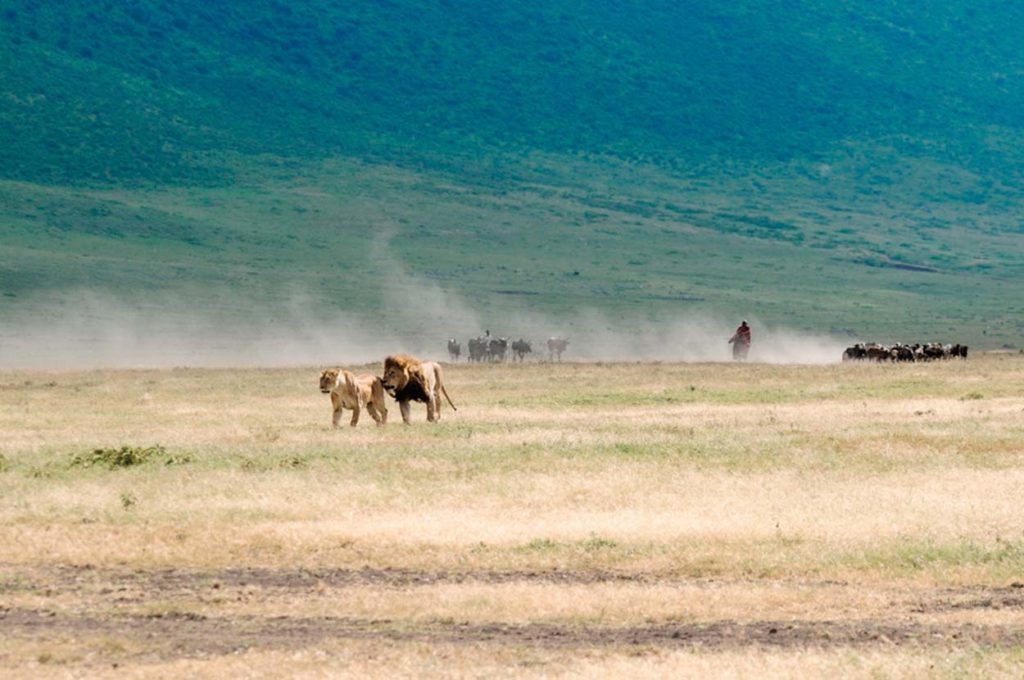
Well fed lions are no threat to herding Maasai
In 2013 an outside coalition of males appeared in the crater that managed to bring in new genes into the interbred Crater population. Their entry led to a cub boom with high survival. A possible reason for this boost in fertility may be due to new genes flowing in! Another possible and/or additional reason is the pride sisters’ ability to synchronize births following male take-overs. With many cubs born together, and being raised in well protected crèches, their chances of survival increases.
In 2018 and 2019 we documented the arrival of two independent cases of nomadic males that originated from the Ndutu stronghold; NguvuKazi and Laipangwa, who were able to successfully disperse across Ngorongoro’s multiuse area with the protection of KopeLion’s ‘corridor of tolerance’.
Between 2014-2018 numerous cubs were born and many survived into adulthood. Thereafter reproduction has dropped – an effect of the lionesses busy raising juveniles, and commotion and infanticide following male takeovers.
2022 – for the past few years a 5 strong coalition of males has ruled the Crater. Interestingly, despite the stability, there are currently fewer lions in the Crater than previously. Adolescent males are pushed out and no other males are condoned in the crater. Fewer cubs are being born as females come into estrus, and females appear bored with their handsome quintet.
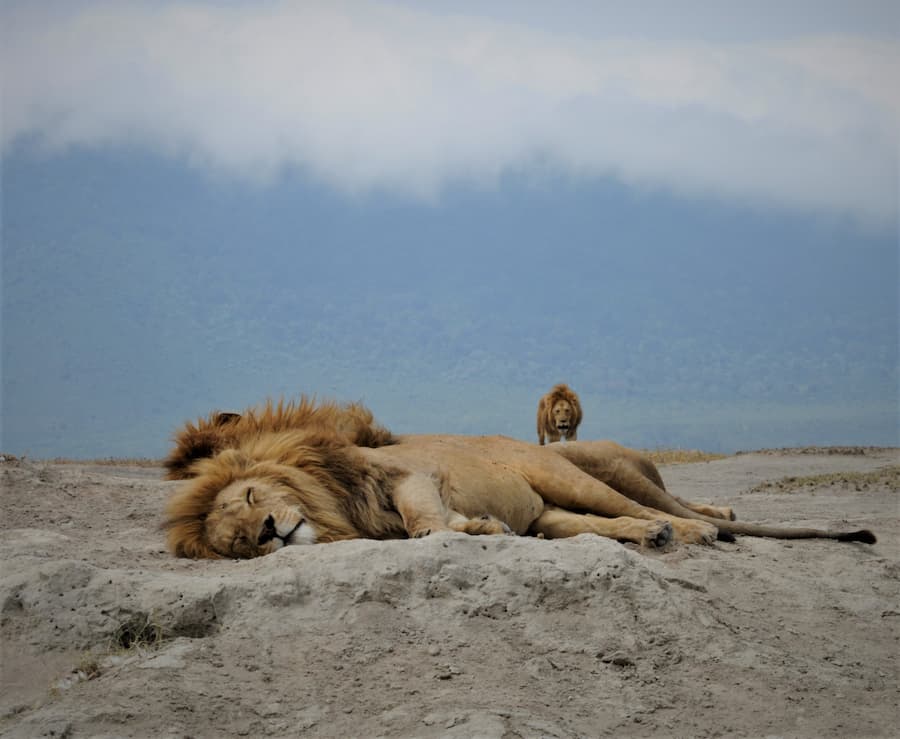
The Lake Quintett have ruled the Crater prides for the last few years, with other males unable to get a look in.
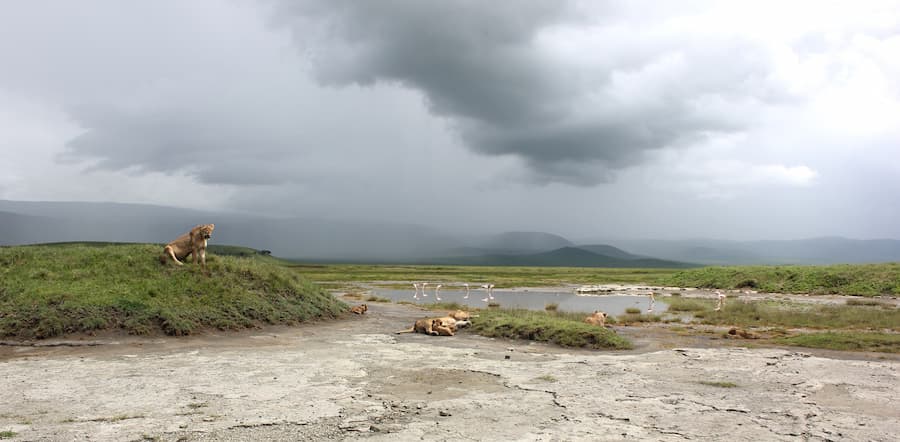
The Munge Mabinti, currently the dominant pride in the Crater.
A genetic study on the Crater lions is currently underway and will determine the success of the ‘Corridor of Tolerance’ in increasing the Crater gene pool.
Ndutu Lions
By April 2022 there are four prides and a total of 45 lions in the Ndutu region (not including visiting groups and nomads). 49% are adults i.e. 4 years and older.
The marshes of Ndutu are a wildlife refuge and the core area of Big Marsh pride. Livestock is not permitted to enter this area and the Big Marsh depend on wild prey, and often struggle for survival in the lean, dry season.
South of Lake Ndutu and lake Masek are the core areas for the Masek and Twin Hill prides. This area fills with people and herds of livestock during the dry season. With the main purpose of preventing conflicts between lions and livestock we have deployed GPS collars on one lioness, Nadine and one juvenile male, Lendepesi, who is now off wandering with his brother, from the Twin Hill pride. We also have a male collared, named Lopirr, or Buddah, who recently moved into Ndutu with his brothers, causing havoc and succeeding in taking over the Twin Hill pride.
From the collar data we gained insight to the shift in behaviour of the lions that we all assumed moved off during the dry season. They did not disappear. To the contrary, they were often closer than you imagined, securely tucked into dense vegetation during day-light hours. At night they nip out, often hunting or scavenging lost or dying livestock, occasionally bringing down a giraffe. We often find them better fed compared to their Big Marsh neighbours due to the easy (but dangerous!) access to livestock. As rains return and the pastoralists move off with their herds, these lions resume more relaxed behaviours, become more active in daytime, and we often find them resting and playing out in the open.
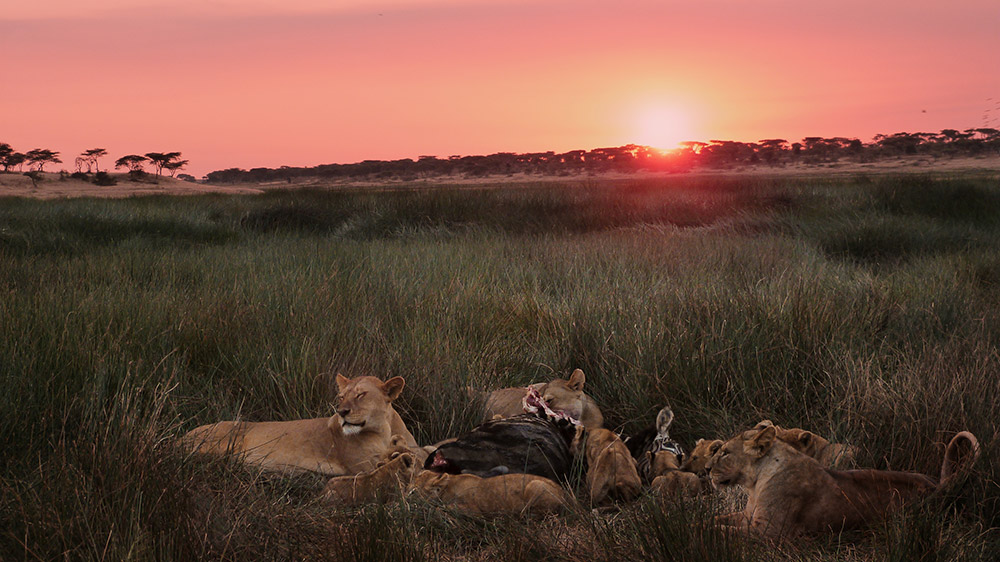
Sun setting over Ndutu’s Big Marsh. The pride bearing the name of the area in a content pile on top of their recent zebra-kill.
Multi-Use Area Lions and the ‘Corridor of Tolerance’
Our current count of lions in the multi-use section of Ngorongoro, between the Ngorongoro Crater and the Ndutu region, is never 100% certain. Lions are rarely seen and instead we rely on signs – like tracks, hair or scat. Our current best guesstimate for 2020 is 10-30 individuals, including up to 13 individuals that departed from the Ngorongoro Crater and settled on the north eastern rim of the crater, but who in 2022 have largely dispersed and disappeared.
One of the lions in this multi-use area is GPS collared; Lemunge (aka MG130), originating from the Crater and now settled with females, and in the Laetoli Valley and surrounding areas.
In the last couple of years, we’ve seen more lion observations in the multi-use areas, and that lion stay here for longer times. In these landscapes shared with people, encounters with livestock and potential conflicts are common. The lions target wild prey when they can, but occasionally people’s valued cattle are on the menu. Conflicts erupt and livestock owners can incur high, sometimes detrimental costs, to their livelihoods.
Our approach to prevent and alleviate conflicts together with the pastoralist communities of the NCA is valued and is reflected in the increased tolerance we now see towards lion, and more resigned acceptance of attack events.
Coexistence is all in the balance, and we believe that lions can make use of these multi-use areas, and this balance can be attained, but only with support towards better protection for both lions and livestock, conflict mitigation, and some tangible benefits from lion conservation.
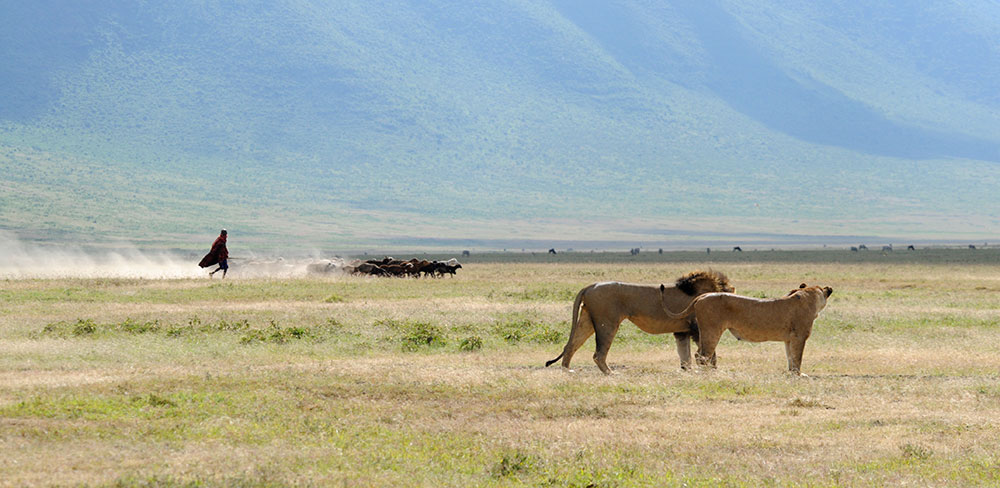
KopeLion lions and maasai in the Ngorongoro Crater
